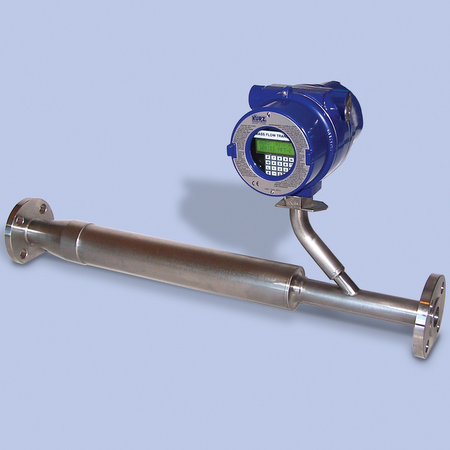Thermal mass flowmeters can offer a reliable, responsive and accurate method of air and gas flow measurement over wide operating range. They create negligible pressure drop and have no moving parts prone to failure and wear. Additionally, due to the principles involved, thermal mass flowmeters are self compensating for pressure and temperature.
The basic technology of a thermal mass flowmeter involves 2x temperature sensing elements (typically RTDs)….
– 1x measures the gas temperature
– 1x heated element
In a traditional Constant Power Thermal Anemometer (CPA) constant power is applied to the heated element. Due to thermal conductivity, as flow rate increases heat is drawn away from the heated sensor. This cools the heated element, reducing the temperature differential between each RTD element. The temperature differential measured by the CPA thermal mass flowmeter is therefore indicative of flow rate. The inbuilt electronics will condition the signal appropriately.
In a Constant Temperature Thermal Anemometer (CTA) the heated element is instead heated to a constant temperature differential above the gas process temperature. In CTA technology therefore the changing power required to maintain this temperature differential is indicative of flow rate. Again, inbuilt electronics will condition the signal appropriately.
CPA vs CTA Thermal Mass Flowmeters
Traditional CPA thermal mass flowmeters have been assessed as problematic at extremities of their measurement range:
Zero reading is unreliable. Where no flow occurs the temperature difference is very high. As there is no flow to “draw” the heat away, convection can heat the gas measurement element.
At the high end of the range, the temperature difference is very small. This itself leads to issues with resolution and uncertanty of the RTD element, where even a small temperature uncertainty is exaggerated into a large flow change.
In a CTA thermal aneometer, the temperature difference is constant. The ‘ideal’ temperature difference maybe researched by the manufacturer and selected to create the least uncertainty across the entire measurement spectrum.
Industry
Fluidic are the UK distribution point for all Kurz CTA Thermal Mass Flowmeters. Probably the most common application would be burner control, common in power stations, steelworks, glassworks etc… A well controlled burner system is imperative to ensure a clean and efficient energy control system. Traditional DP methods of flow monitoring (annubar/pitot tube) do not lend themselves well to a dirty process where small orifices in the measurement system can clog.
Due to the accurate, responsive and reliable range nature of Kurz Thermal Mass Flowmeters we also have supplied many to ventillation applications in safety critical systems. In the UK nuclear industry, Kurz (via Fluidic) is the preferred option and have been EMPHASIS assessed in accordance with this.
Application notes
Thermal Mass Flowmeters are (as the title suggests!) primarily instruments to measure mass flow. The number of molecules passing over the elements – along with the properties of these molecules – are what determines the cooling effect and flowrate measurement. Due to this, readings are self compensating for pressure (more pressure = more molecules). At time of order it is imperative to indicate the process gas in the application. Due to thermal properties, some gases could effect reading as much as 10x that of, say, air. Via Kurz Instruments, Fluidic are able to supply the thermal mass flowmeter calibrated specifically for your application.
Kurz 454FTB Insertion CTA thermal mass flowmeter
Kurz 504FTB inline CTA thermal mass flowmeter
Kurz 534FTB inline CTA thermal mass flowmeter (with flow straightener)
For more information on wireless instrumentation, please call your local Fluidic office. To receive more technical application notes like this please click the subscribe link below.

